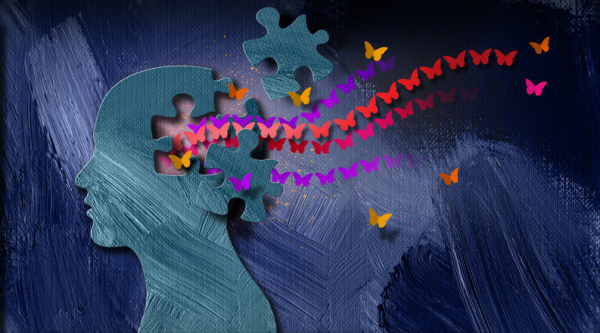
Months after actor and comedian Robin Williams took his own life in August 2014, autopsy results revealed he had a devastating disease: Lewy body dementia (LBD). Unlike Alzheimer’s disease and even frontotemporal dementia, this brain disorder has tended to hide in the shadows. But work is underway to change that, says Dr. Stephen Gomperts, an assistant professor of neurology at Harvard Medical School and director of the Lewy Body Dementia Unit at Harvard-affiliated Massachusetts General Hospital.
Perhaps surprisingly, LBD is the second most common cause of neurodegenerative dementia after Alzheimer’s disease. How do its symptoms differ? Who is at risk? And how is it diagnosed and treated?
What is Lewy body dementia?
First, it’s important to know that there are two main types of this dementia. One is called dementia with Lewy bodies, or DLB. A second type, known as Parkinson’s disease dementia, or PDD, may arise late in the course of that illness.
These disorders stem from an abnormal buildup of protein deposits in the brain called Lewy bodies. The deposits, formed from a protein called alpha-synuclein, settle in brain areas affecting thinking, behavior, perception, and movement.
Much like Alzheimer’s disease, LBD is progressive and ultimately fatal. But while the median lifespan of people who have this illness is seven years, there is a high degree of variation in the duration of disease, says Dr. Gomperts. “Many people respond well to medicines that aim to improve their ability to function and quality of life.”
How common is it?
More than a million Americans live with Lewy body dementia. Others who likely have the disease may not have sought care or have been misdiagnosed, Dr. Gomperts says. “In the past, LBD was often subsumed under the general umbrella of ‘dementia’ or ‘Alzheimer’s.’ It’s still significantly underdiagnosed, but that’s getting better.”
Most people with LBD develop symptoms after age 50, so the numbers are likely to grow as the population continues to age.
How is Lewy body dementia similar to Alzheimer’s disease?
As with Alzheimer’s, LBD affects a person’s ability to think clearly, remember details, solve problems, focus on tasks, and eventually to care for themselves. “Gradually progressive trouble with thinking is the key shared feature between the two. This initially doesn’t impact activities of daily living, but ultimately it does,” he explains.
How does Lewy body dementia differ from Alzheimer’s disease?
In Alzheimer’s disease, memory problems usually occur early and are the dominant problem. In contrast, in LBD, difficulties with problem-solving or spatial problems tend to arise before memory difficulties. But any of these symptoms can occur first or in combination, and they may fluctuate. Perception is often affected, which can manifest as visual hallucinations. Delusions (false beliefs) are also common as the disease progresses.
“Whereas hallucinations and delusions are common late in the course of Alzheimer’s disease, visual hallucinations often arise early in LBD. For example, a person with LBD might see people or animals that aren’t there,” he says. “Such hallucinations are only rarely perceived as threatening.”
Other differences are:
- Acting out dreams. People with LBD may act out their dreams. Known as REM sleep behavioral disorder, this problem often arises even before thinking problems start.
- Changes in movement. People with Lewy body dementia often move slowly and stiffly, developing tremors and gait changes and becoming prone to falls. When people have PDD, progressive movement problems arise early and are the rule. This symptom leads to the initial diagnosis of Parkinson’s disease. In DLB, movement is often but not always affected.
How do experts distinguish between PDD and DLB?
It’s all in the timing of key symptoms. A “one-year rule” distinguishes each disorder.
- PDD: When someone diagnosed with Parkinson’s develops memory and thinking problems that impair activities of daily living more than a year after their movement problems arise, PDD is diagnosed.
- DLB: When cognitive problems arise earlier, or come without movement problems, dementia with Lewy bodies is diagnosed.
“But this one-year rule is somewhat arbitrary,” Dr. Gomperts says. “Increasingly we think of this as a spectrum of disease.”
Who is at risk for Lewy body dementia?
Age is considered the biggest risk factor for the disease. Most cases have no known trigger, although a handful of gene mutations can predispose someone to LBD.
Several lifestyle factors such as diet, lack of exercise, and toxic exposures have been linked to Parkinson’s disease risk. However, little research has been done to examine whether these factors are linked to LBD. People who have suffered head trauma appear to develop LBD and Parkinson’s more often. Both conditions also disproportionately affect men. “We think that’s telling us something important, but it’s not yet clear what,” Dr. Gomperts says.
How is Lewy body dementia diagnosed?
The diagnosis of DLB is made when key clinical features are present — trouble thinking, fluctuations in thinking, movement problems, and REM sleep behavioral disorder — in the absence of other causes. The diagnosis of PDD is made when dementia arises in Parkinson’s disease.
Diagnosing DLB is challenging because early symptoms are often confused with symptoms that arise in other brain or psychiatric disorders. Many people don’t receive an accurate diagnosis until their symptoms become more advanced, Dr. Gomperts says.
An array of tests and imaging exams is deployed to tease out LBD from other conditions that can trigger similar symptoms, such as Alzheimer’s disease, vascular disease, thyroid disorders, or vitamin B12 deficiency.
“Not all cases are clear-cut and not all physicians are skilled at making the diagnosis,” he says. “Accuracy is also lower in early disease.”
Are there treatments for Lewy body dementia?
Yes. Although there’s no cure, treatments like medications, physical therapy, and counseling can help with specific symptoms of LBD, such as thinking problems, hallucinations, and sleep disturbances. LBD-related movement symptoms can also be treated with some medications used for Parkinson’s. This makes it easier to walk and do other activities.
“We’ve also learned that several medications can cause or worsen certain symptoms, such as confusion, delusions, hallucinations, and movement problems,” Dr. Gomperts says. “In fact, some medications that target hallucinations and delusions often worsen motor function and can even be fatal in LBD. They need to be avoided.”
About the Author

Maureen Salamon, Executive Editor, Harvard Women's Health Watch
Maureen Salamon is executive editor of Harvard Women’s Health Watch. She began her career as a newspaper reporter and later covered health and medicine for a wide variety of websites, magazines, and hospitals. Her work has … See Full Bio View all posts by Maureen Salamon
About the Reviewer

Howard E. LeWine, MD, Chief Medical Editor, Harvard Health Publishing
Dr. Howard LeWine is a practicing internist at Brigham and Women’s Hospital in Boston, Chief Medical Editor at Harvard Health Publishing, and editor in chief of Harvard Men’s Health Watch. See Full Bio View all posts by Howard E. LeWine, MD
 poohsstructurally
poohsstructurally
